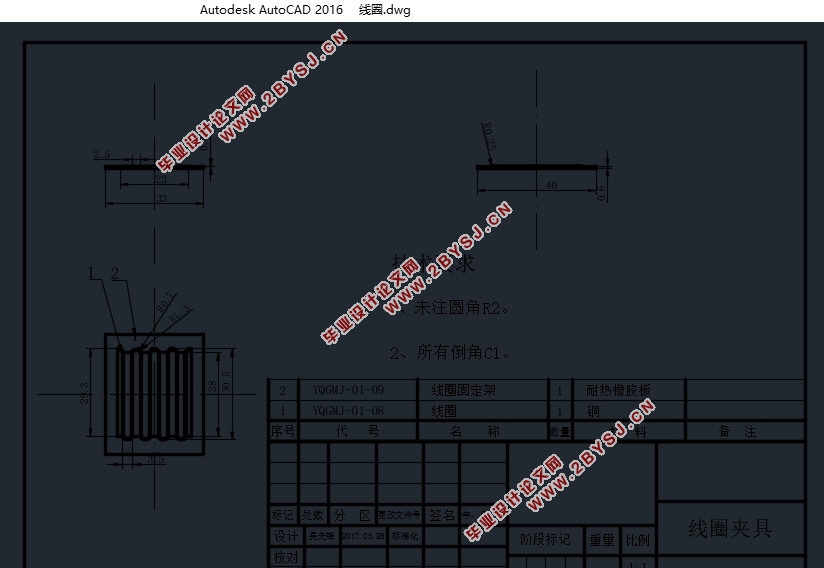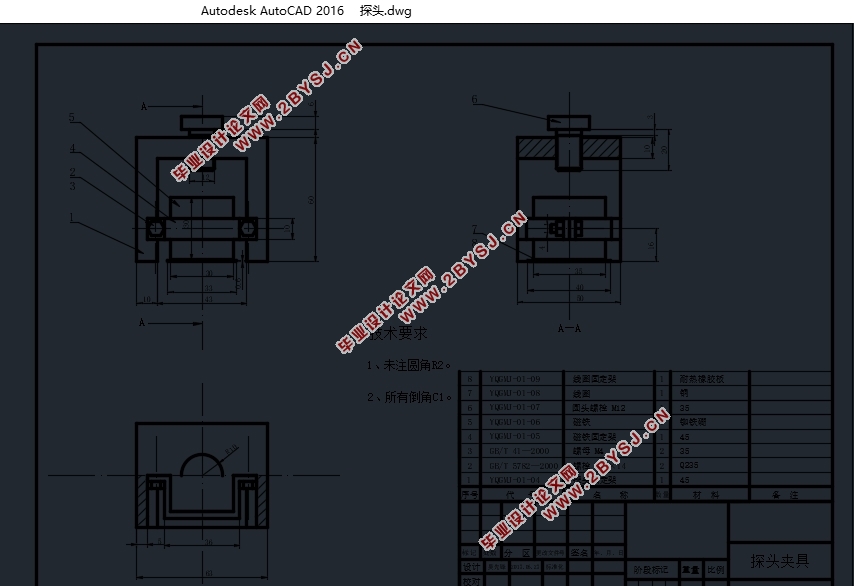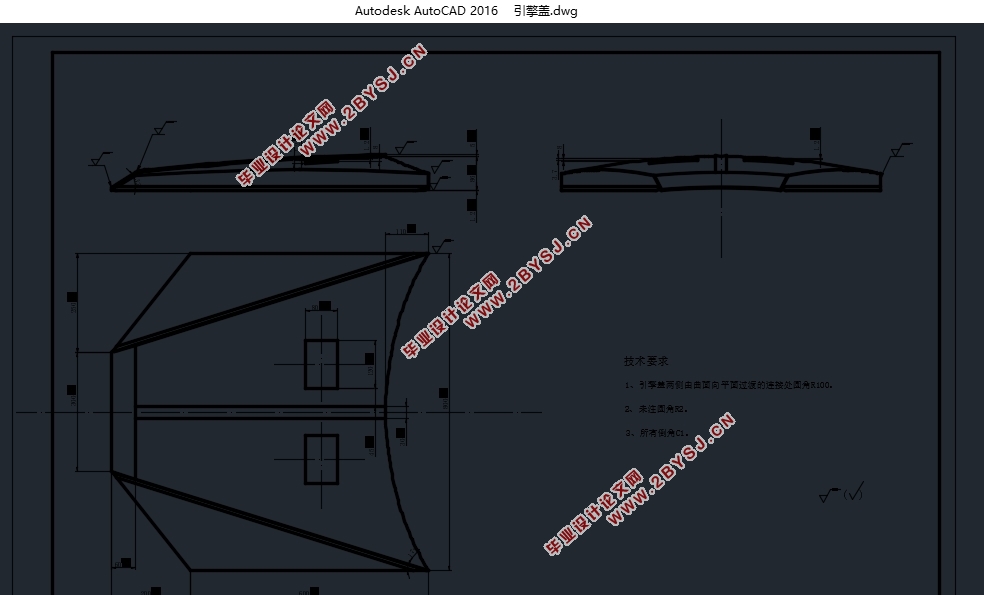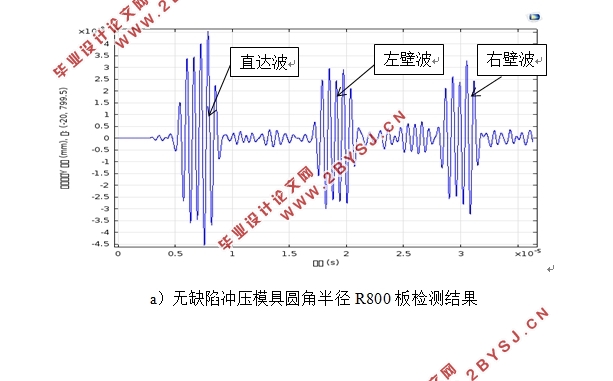汽车冲压模具缺陷超声无损检测工艺设计(含CAD图)
无需注册登录,支付后按照提示操作即可获取该资料.
汽车冲压模具缺陷超声无损检测工艺设计(含CAD图)(任务书,开题报告,文献摘要,外文翻译,论文说明书16000字,CAD图6张)
摘要
在我国经济高速发展,人民生活水平普遍提高的发展形势下,汽车行业也迎来了巨大的发展机遇,汽车产量达到几千万辆。如此巨大的产量也就对汽车冲压模具的产量和质量提出更高的要求。但在汽车冲压模具的实际生产中不可避免的会出现缺陷问题,这也就需要对汽车冲压模具进行缺陷检测。电磁超声换能器由于其本身的不需要耦合剂、无接触、分辨率高等优点而在无损检测方面受到了广大的关注,可以运用于对汽车冲压模具的无损检测。本文以电磁超声表面波理论为基础,研究了电磁超声表面波在汽车冲压模具中的应用。
本论文设计了电磁超声换能器的探头及探头夹具,理论研究了金属板中表面波的产生,确定了激励频率,着重研究表面波在对不同曲率模具进行检测时的差异。为达到研究目的,将研究模型分为五组,分别为平板、R200板、R400板、R600板、R800板,各组又分为有缺陷和无缺陷两个模型,并进行相应的仿真研究。
五组模型的仿真结果分别进行组内对照和组间对照。组内对照即为有缺陷板与无缺陷板对照,以确定缺陷反射波,从而判断缺陷位置。组间对照即为各组模型间相互对照,以判断不同曲率模型的结果差异。从最后的仿真结果来看,组内对照可以快速找出缺陷饭反射波,并较为精确的读取缺陷的位置,组间对照发现大曲率板相较于小曲率板,会有更多的杂波,当所设置的缺陷较小时易被杂波所覆盖,也就说明,用表面波进行无损检测时,其对检测工件的表面形状有一定要求,即当工件表面超过一定曲率时,而缺陷又很小时,可能无法得到检测结果,故表面波用于平面板检测效果会更好。
关键词:电磁超声,表面波,换能器探头设计,缺陷检测,有限元分析
Ultrasonic nondestructive testing of automobile stamping die defect
Abstract
In China's rapid economic development, people's living standards generally improve the development of the situation, the automotive industry also ushered in a huge opportunity for development, car production reached tens of millions of vehicles. Such a huge production of automotive stamping die on the production and quality of a higher demand. But in the actual production of automotive stamping die inevitably there will be defects, which also need to test the car stamping die defects. Electromagnetic ultrasonic transducer because of its own need no coupling agent, no contact, high resolution and other advantages in the nondestructive testing has been the majority of attention, can be applied to the automotive stamping die nondestructive testing. Based on the electromagnetic ultrasonic surface wave theory, the application of electromagnetic ultrasonic surface wave in automobile stamping die is studied.
In this paper, the probe and probe fixture of electromagnetic ultrasonic transducer are designed. The generation of surface wave in metal plate is studied theoretically. The excitation frequency is determined, and the difference of surface wave in detecting different curvature mold is studied emphatically. For the purpose of research, the research model is divided into five groups: flat plate, R200 plate, R400 plate, R600 plate and R800 plate. The group is divided into two models: defective and defect-free, and the corresponding simulation research is carried out.
The simulation results of the five groups were compared between the groups and the control group. Group control is a defective plate and no defect plate control to determine the defect reflected wave, so as to determine the defect location. The comparison between groups was the control of each group model to judge the difference of the results of different curvature models. From the final simulation results, the group control can quickly find the defective rice reflection wave, and more accurately read the location of the defect, the group found that compared with the small curvature of the small curvature plate, there will be more miscellaneous Wave, when the set of defects are small when the cover is easy to cover, it shows that the surface wave for non-destructive testing, the detection of the workpiece surface shape has certain requirements, that is, when the workpiece surface exceeds a certain curvature, Very small, may not be able to get the test results, so the surface wave for the flat panel detection effect will be better.
Key words: electromagnetic ultrasonic, surface wave, transducer probe design, defect detection, finite element analysis
主要研究内容
本文的研究工作分为两个部分。其一为设计电磁超声换能器及探头夹具。其二是利用表面波进行金属板的缺陷检测仿真。研究内容如下:
(1)研究电磁超声表面波的产生条件以及产生机理,并据此设计相应的探头,为其后的模型建立创造条件,确保在仿真时可以产生需要的表面波。
(2)研究电磁超声表面波的检测机理,明确其检测原理,以为其后的模型仿真确定仿真步骤及条件设置。
(3)利用comsol建立相应的多组缺陷板模型,并进行电磁超声表面波的缺陷检测仿真,研究不同曲率板对检测结果的影响,通过最后的检测结果分析缺陷的位置。





目录
摘要 I
Abstract II
1 绪论 1
1.1 课题研究目的和意义 1
1.2 国内外的研究现状 2
1.2.1 电磁超声检测技术国外发展状况 3
1.2.2 电磁超声检测技术国内发展状况 4
1.3 主要研究内容 4
2 板中的超声波 5
2.1 超声波的概念 5
2.2 超声导波的概念 5
2.3 金属板中的表面波 6
2.4 本章小结 6
3 电磁超声换能器的设计 7
3.1 电磁超声换能器的工作原理 7
3.2 电磁超声换能器的换能机理 7
3.3 电磁超声换能器探头及夹具的设计 8
3.3.1 线圈的设计 8
3.3.2 磁铁的设计 10
3.3.3 探头夹具的设计 10
3.4 本章小结 11
4 电磁超声表面波的检测有限元仿真研究 12
4.1 有限元仿真软件—COMSOL Multiphysics 12
4.2 电磁超声表面波的检测仿真 12
4.2.1 磁铁的静态磁场仿真 12
4.2.2 感应涡流和洛伦兹力的仿真 13
4.2.3 表面波传播的模拟 15
4.2.4 振动感应涡流的模拟 15
4.2.5 感应电动势的模拟 16
4.3 冲压模具各圆角半径板缺陷检测仿真结果分析 16
4.3.1 冲压模具无圆角板缺陷检测结果分析 17
4.3.2 冲压模具圆角半径R200板缺陷检测结果分析 19
4.3.3 冲压模具圆角半径R400板缺陷检测结果分析 21
4.3.4 冲压模具圆角半径R600板缺陷检测结果分析 22
4.3.5 冲压模具圆角半径R800板缺陷检测结果分析 24
4.4 缺陷检测仿真结果对比分析 26
4.5 本章小结 27
参考文献 28
致谢 30
